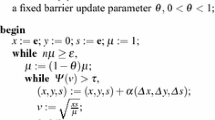Abstract
Primal-Dual Interior-Point Methods (IPMs) have shown their power in solving large classes of optimization problems. In this paper a self-regular proximity based Infeasible Interior Point Method (IIPM) is proposed for linear optimization problems. First we mention some interesting properties of a specific self-regular proximity function, studied recently by Peng and Terlaky, and use it to define infeasible neighborhoods. These simple but interesting properties of the proximity function indicate that, when the current iterate is in a large neighborhood of the central path, large-update IIPMs emerge as the only natural choice. Then, we apply these results to design a specific self-regularity based dynamic large-update IIPM in large neighborhood. The new dynamic IIPM always takes large-updates and does not utilize any inner iteration to get centered. An \(O(n^{2}\log{\frac{n}{\epsilon}})\) worst-case iteration bound of the algorithm is established. Finally, we report the main results of our computational experiments.
Similar content being viewed by others
References
E.D. Andersen, C. Roos, T. Terlaky, T. Trafalis, and J.P. Warners, “The use of low-rank updates in interior-point methods,” in Numerical Linear Algebra and Optimization, Y. Yuan (Ed.), Science Press, Beijing, China, pp. 1–12, 2004.
A. Gupta, WSMP: Watson Sparse Matrix Package (Part I: Direct solution of symmetric sparce systems). Technical Report RC 21866(98462), IBM T.J. Watson Research Center, Yorktown Heights, NY, 2000. http://www.cs.umn.edu/~agupta/wsmp.html
N. Karmarkar, “New polynomial-time algorithm for linear programming,” Combinatorica, vol. 4, pp. 373–395, 1984.
M. Kojima, “Basic lemmas in polynomial-time infeasible-interior-point methods for linear programs,” Annals of Operations Research, vol. 62, pp. 1–28, 1996.
M. Kojima, N. Megiddo, and S. Mizuno, “A primal-dual infeasible-interior-point algorithm for linear programming,” Mathematical Programming, vol. 61, pp. 263–280, 1993.
I.J. Lustig, “Interior point methods: Computational state of the art,” Linear Algebra and Its Applications, vol. 152, pp. 191–222, 1993.
I.J. Lustig, “Feasible issues in a primal-dual interior-point methods for linear programming,” Mathematical Programming, vol. 49, pp. 145–162, 1990/91.
S. Mehrotra, “On the implementation of a primal-dual interior point method,” SIAM Journal on Optimization, vol. 2, pp. 575–601, 1992.
S. Mizuno, “Polynomiality of infeasible-interior-point algorithms for linear programming,” Mathematical Programming, vol. 67, pp. 109–119, 1994.
R.D.C. Monteiro and I. Adler, “Interior path following primal-dual algorithms. Part I: Linear programming,” Mathematical Programming, vol. 44, pp. 27–41, 1989.
OSL: The Optimization Solution Library. Home page: http://www-3.ibm.com/software/data/bi/index.html
J. Peng, C. Roos, and T. Terlaky, Self-Regularity: A New Paradigm for Primal-Dual Interior-Point Algorithms. Princeton University Press: Princeton, NJ, 2002.
J. Peng and T. Terlaky, “A dynamic large-update primal-dual interior-point methods for linear optimizaion,” Optimization Methods and Software, vol. 17, pp. 1077–1104, 2002.
J. Peng, C. Roos, and T. Terlaky, “Self-Regular proximities and new search directions for linear and semidefinite optimization,” Mathematical Programming, vol. 93, pp. 129–171, 2002.
F.A. Potra, “A quadratically convergence predictor-corrector method for solving linear programs from infeasible starting points,” Mathematical Programming, vol. 67, pp. 383–406, 1994.
C. Roos, T. Terlaky, and J.-Ph. Vial, Theory and Algorithms for Linear Optimization. An Interior Point Approach. John Wiley and Sons: Chichester, UK, 1997.
D. Shanno and E. Simantiraki, “An infeasible interior-point method for linear complementarity problems,” SIAM Journal on Optimization, vol. 7, no. 3, pp. 620–640, 1997.
J. Stoer, M. Wechs, and S. Mizuno, “High order infeasible-interior-point methods for solving sufficient linear complementarity problems,” in System Modeling and Optimization, Detroit, MI, Chapman Hall/CRC Res. Notes Math., vol. 396, pp. 245–252, 1997.
K. Tanabe, “Centered Newton method for linear programming: Interior and ‘exterior’ point method (in Janpanese),” in New Methods for Linear Programming, K. Tone (Ed.), vol. 3, pp. 98–100, 1990.
T. Terlaky (Ed.), Interior Point Methods of Mathematical Programming. Kluwer Academic Publishers, 1996.
M.J. Todd and Y. Ye, “Approximate Farkas lemmas and stopping rules for iterative infeasible-point algorithms for linear programming,” Mathematical Programming, vol. 81, pp. 1–21, 1998.
P. Tseng, “Analysis of an infeasible interior path-following method for complementarity problems,” SIAM Journal on Optimization, vol. 7, no. 2, pp. 386–402, 1997.
R.H. Tütüncü, “An infeasible-interior-point potential-reduction algorithm for linear programming,” Mathematical Programming, vol. 86, no. 2, pp. 313–334, 1999.
S.J. Wright, Primal-Dual Interior-Point Methods. SIAM: Philadelphia, 1996.
S.J. Wright, “An infeasible-interior-point algorithm for linear complementarity problems,” Mathematical Programming,” vol. 67, pp. 29–52, 1994.
S.J. Wright and Y. Zhang, “A superquadratic infeasible-interior-point method for linear complementarity problems,” Mathematical Programming, vol. 73, no. 3, pp. 269–289, 1996.
Y. Ye, Interior-Point Algorithms, Theory and Analysis. John Wiley & Sons: Chichester, UK, 1997.
Y. Ye, M.J. Todd, and S. Mizuno, “An \(O(\sqrt{n}L\))-iteration homogeneous and self-dual linear programming algorithm,” Mathematics of Operations Research, vol. 19, pp. 53–67, 1994.
Y. Zhang, “On the convergence of a class of infeasible-interior-point methods for the horizantal linear complementarity problem,” SIAM Journal on Optimization, vol. 4, pp. 208–227, 1994.
Y. Zhang, “Solving large-scale linear programs by interior-point methods under the MATLAB environment,” Optimization Methods and Software, vol. 10, pp. 1–31, 1999.
Y. Zhang, “User's Guide to LIPSOL Linear-programming Interior Point Solvers V0.4.”, Optimization Methods and Software, vol. 11/12, pp. 385–396, 1999.
Author information
Authors and Affiliations
Corresponding author
Rights and permissions
About this article
Cite this article
Salahi, M., Terlaky, T. & Zhang, G. The Complexity of Self-Regular Proximity Based Infeasible IPMs. Comput Optim Applic 33, 157–185 (2006). https://doi.org/10.1007/s10589-005-3064-1
Received:
Revised:
Accepted:
Published:
Issue Date:
DOI: https://doi.org/10.1007/s10589-005-3064-1




